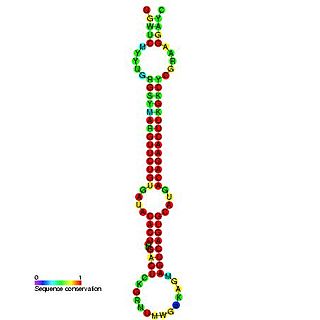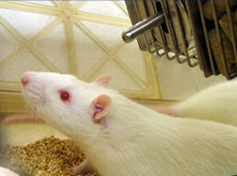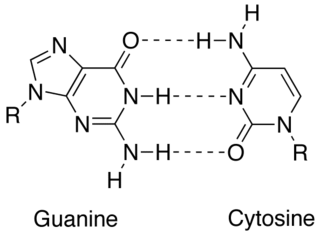
In genetics, complementary DNA (cDNA) is DNA synthesized from a single-stranded RNA template in a reaction catalyzed by the enzyme reverse transcriptase. cDNA is often used to clone eukaryotic genes in prokaryotes. When scientists want to express a specific protein in a cell that does not normally express that protein, they will transfer the cDNA that codes for the protein to the recipient cell. cDNA is also produced naturally by retroviruses and then integrated into the host's genome, where it creates a provirus.
In genetics, an expressed sequence tag (EST) is a short sub-sequence of a cDNA sequence. ESTs may be used to identify gene transcripts, and are instrumental in gene discovery and in gene-sequence determination. The identification of ESTs has proceeded rapidly, with approximately 74.2 million ESTs now available in public databases.
This is a list of topics in molecular biology. See also index of biochemistry articles.

A short hairpin RNA or small hairpin RNA is an artificial RNA molecule with a tight hairpin turn that can be used to silence target gene expression via RNA interference (RNAi). Expression of shRNA in cells is typically accomplished by delivery of plasmids or through viral or bacterial vectors. shRNA is an advantageous mediator of RNAi in that it has a relatively low rate of degradation and turnover. However, it requires use of an expression vector, which has the potential to cause side effects in medicinal applications.

Potassium voltage-gated channel subfamily A member 1 also known as Kv1.1 is a shaker related voltage-gated potassium channel that in humans is encoded by the KCNA1 gene. The Isaacs syndrome is a result of an autoimmune reaction against the Kv1.1 ion channel.
RNA silencing or RNA interference refers to a family of gene silencing effects by which gene expression is negatively regulated by non-coding RNAs such as microRNAs. RNA silencing may also be defined as sequence-specific regulation of gene expression triggered by double-stranded RNA (dsRNA). RNA silencing mechanisms are highly conserved in most eukaryotes. The most common and well-studied example is RNA interference (RNAi), in which endogenously expressed microRNA (miRNA) or exogenously derived small interfering RNA (siRNA) induces the degradation of complementary messenger RNA. Other classes of small RNA have been identified, including piwi-interacting RNA (piRNA) and its subspecies repeat associated small interfering RNA (rasiRNA).

In molecular biology, miR-148 is a microRNA whose expression has been demonstrated in human, mouse, rat and zebrafish. miR-148 has also been predicted in chicken.

DNA polymerase, beta, also known as POLB, is an enzyme present in eukaryotes. In humans, it is encoded by the POLB gene.

Hypermethylated in cancer 2 protein is a protein that in humans is encoded by the HIC2 gene.

Protein ZNF365 is a protein that in humans is encoded by the ZNF365 gene.
Dharmacon Inc., now known as Dharmacon, a Horizon Discovery Group company, was founded in 1995 by Stephen Scaringe as Dharmacon Research to develop and commercialize a new technology for RNA oligonucleotide synthesis. The original Dharmacon focus and vision was to develop 2'-ACE RNA technology as the standard for RNA synthesis and to advance RNA oligo-dependent applications and technologies. When RNA interference (RNAi) emerged in the late 1990s, Dharmacon was poised to provide RNAi-related products to the multitude of academic and industry researchers. Dharmacon has become an important resource for those investigating the mechanisms of siRNA -induced gene knockdown and applying the specificity and potency of RNAi to human biotherapeutics. Dharmacon's expertise in bioinformatics, RNA biology, and synthesis chemistry has allowed it to develop a complete line of products for the RNAi researcher.
IMAGE cDNA clones are a collection of DNA vectors containing cDNAs from various organisms including human, mouse, rat, non-human primates, zebrafish, pufferfish, Xenopus (frogs), and cow. Together they represent a more or less complete set of expressed genes from these organisms. IMAGE stands for integrated molecular analysis of genomes and their expression.
Chloride channel accessory 3, also known as CLCA3, is a protein which in humans is encoded by the CLCA3P pseudogene. The protein encoded by this gene is a chloride channel. According to the HGNC, this protein is not expressed in humans but is in certain other species such as mouse. However, some conflicting reports state that human cells produce and glycosylate this protein.

A knockout rat is a genetically engineered rat with a single gene turned off through a targeted mutation used for academic and pharmaceutical research. Knockout rats can mimic human diseases and are important tools for studying gene function and for drug discovery and development. The production of knockout rats was not economically or technically feasible until 2008.

HIKESHI is a protein important in lung and multicellular organismal development that, in humans, is encoded by the HIKESHI gene. HIKESHI is found on chromosome 11 in humans and chromosome 7 in mice. Similar sequences (orthologs) are found in most animal and fungal species. The mouse homolog, lethal gene on chromosome 7 Rinchik 6 protein is encoded by the l7Rn6 gene. When the l7Rn6 protein is disrupted in mice, the mice display severe emphysema at birth as a result of disorganization of the Golgi apparatus and formation of aberrant vesicular structures within club cells.

In molecular biology, complementarity describes a relationship between two structures each following the lock-and-key principle. In nature complementarity is the base principle of DNA replication and transcription as it is a property shared between two DNA or RNA sequences, such that when they are aligned antiparallel to each other, the nucleotide bases at each position in the sequences will be complementary, much like looking in the mirror and seeing the reverse of things. This complementary base pairing allows cells to copy information from one generation to another and even find and repair damage to the information stored in the sequences.

caprin family member 2, also known as CAPRIN2, is a human gene.
Benitec Biopharma Ltd ASX: BLT is an Australian biotechnology company founded in 1997. It is engaged in the development of gene-silencing therapies for the treatment of chronic and life-threatening diseases using DNA-directed RNA interference (ddRNAi) technology.

DNA-directed RNA interference (ddRNAi) is a gene-silencing technique that utilizes DNA constructs to activate an animal cell’s endogenous RNA interference (RNAi) pathways. DNA constructs are designed to express self-complementary double-stranded RNAs, typically short-hairpin RNAs (shRNA), that once processed bring about silencing of a target gene or genes. Any RNA, including endogenous mRNAs or viral RNAs, can be silenced by designing constructs to express double-stranded RNA complementary to the desired mRNA target.
Gregory James Hannon is a professor of molecular cancer biology and director of the Cancer Research UK Cambridge Institute at the University of Cambridge. He is a Fellow of Trinity College, Cambridge while also serving as a director of cancer genomics at the New York Genome Center and an adjunct professor at Cold Spring Harbor Laboratory.


















